
Large animal rescue occurs during the response phase to a natural or anthropogenic disaster, emergency or accident where specialised training and equipment are required to rescue an animal such as a horse, donkey, cow, other livestock, or ungulate wildlife. Successful and safe rescue requires emergency services personnel with specialist training, access to equipment and engineering resources, local knowledge, an understanding of the social psychology of animal owners. It also requires the co-ordinated efforts of emergency services providers with experts such as veterinarians.
With advances in veterinary medicine, many injured large animals that previously would have died now have a viable chance of survival (Bedenice 2007). However, responders must work within a defined system of incident management and triage, and do so before the situation is irrecoverable. LAR training programs and rescue teams have been developed and refined internationally. More formal organisations include the British Animal Rescue and Trauma Care Association (BARTA1). Since 2008, 90 per cent of UK fire and rescue services have established a formal LAR capability and are trained to a national standard (Green 2014). Their work is informed by well-respected manuals on the topic (Leighton & Staples 2010, Gimenez, Gimenez & Stafford 2007). However, there has been little explicit consideration of the ways in which human and animal safety are mutually incorporated and the challenges posed by the human-animal bond.
Three Australian case studies have been selected for discussion largely due to the availability of first hand, well-documented case material and permissions. The choice to include examples of ‘successful’ and ‘unsuccessful’ rescues is intentional.
A 20-year-old horse was found stuck in mud in a dam. Its owner estimated the horse had been trapped there for around 12 hours. She called a veterinarian, fire and emergency responders.
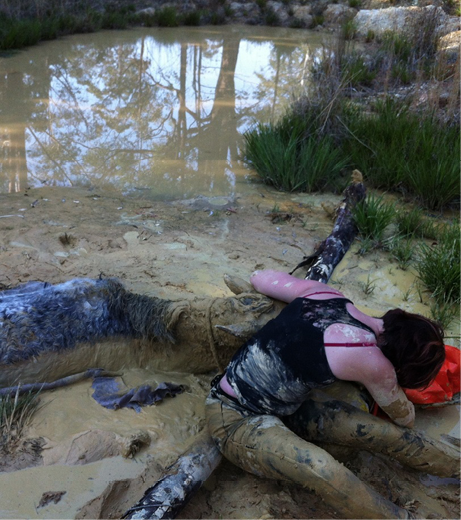
Rescuing large animals from mud is one of the most difficult and dangerous of these rescues. Here the horse’s owner supports its head on a bag of potting mix while she clears mud from its mouth and nostrils.
The Incident Controller (IC) had attended a ‘train the trainers’ weekend where he had learnt basic LAR techniques but not skills specific and critical to successful mud rescues. Normally this would entail the use of water injection around the animal’s limbs to release the suction of the mud before attempting to extricate the animal (Gimenez, Gimenez & Stafford 2007).
The responders had trouble getting strops around the horse, so one volunteer lay on the horse’s back to do it manually. This is not a good option and LAR training provides better ways to handle large animals during mud rescures. Once the strops were in place, it took 40 minutes from the time they began pulling to the time the animal was extricated from the mud because the suction around the limbs had not been released. During that time, rescuers maintained the tension on the strops. The trapped horse was pulled at an angle instead of in a straight line, dragging the strop across the horse’s face.
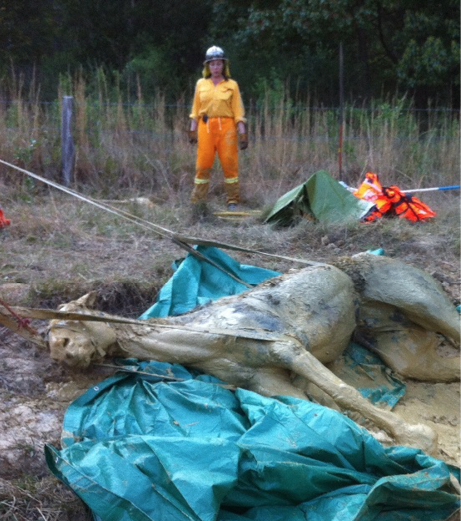
The front strop should be pulled at a 90-degree angle to the horse’s body to avoid drag across the horse’s face and eye.
Once the horse was extricated, it was dragged up a bank and left prone about two metres from a barbed wire fence. As the horse instinctively struggled to stand, it slid closer and closer to the barbed wire. It was too exhausted to prevent its head from hitting the ground after each attempt to rise. The horse’s eye was swollen from trauma associated with the repeated and failed attempts to rise, and the cornea on the downside eye was severely lacerated because a buckle on the halter kept sliding across it during the rescue.
The entire rescue took six hours. It is estimated that with using a Nikopoulos needle and water to release the suction of the mud, it could have taken 30 minutes. The horse had huge sores on its torso from the straps. Because it was resting on one side for so long, it developed pressure sores over the underside of its body and a severely swollen eye. The horse was too exhausted to eat or drink. The dark brown colour of its urine was consistent with dehydration combined with rhabdomyolysis (rapid muscle fibre destruction). The horse never rose and, following consultation with a veterinarian, was humanely euthanised the following day.
During flood preparations, a Royal Society for the Prevention of Cruelty to Animals (RSPCA) inspector was notified of horses stranded on a river island. The water was too high and fast to safely or successfully walk the horses to safety. After consultation between the inspector, responders, and local equine veterinarians, it was decided to return the following day and remove them from the island by boat. As flood rescue requires the horses to be prone and sedated for evacuation by boat, this became a highly organised joint rescue involving four RSPCA inspectors, four responder volunteers, and two veterinarians, all of whom were trained in LAR. Equally importantly some had swift water training.
The following day, the IC identified the hazards posed by the rapidly rising water and assessed the risks to the rescue team. He concluded that the rescue plan was viable and selected procedures that would avoid injuring horses or rescuers. He chose a flat-bottomed bow-loading flood boat, the front of which folded down to form a flat surface for loading a laterally recumbent (sedated or anaesthetised) horse strapped to a rescue glide (an equine version of a backboard for humans).
The IC divided the rescue team into two groups. Two RSPCA inspectors were with the land-based team who remained on shore to help unload the horses and monitor their recovery from sedation. The island rescue team launched the boat and headed downstream. The IC radioed a television helicopter that was filming the flood and asked them to fly over the densely vegetated island to locate the horses. The pilot hovered over the safest point for the boat to land and pointed the helicopter’s nose toward the horses so rescuers wouldn’t waste time searching.
The rescue boat operator navigated the boat through uprooted trees and other debris in the flooded river that, in the intervening 24 hours, had risen a further 1.5 metres. Once safely on the island, the remainder of the team stayed with the boat while a responder and two inspectors approached the horses.
Despite being unhandled for many years, and fearful of the floodwaters and the helicopter, the horses were coaxed into being haltered and led to the handling point near the boat. The veterinarian sedated the first horse and the crew quickly put rescue straps around its torso and dragged it onto a rescue glide. One responder acted as the ‘veterinarian assistant’ responsible for making sure the veterinarian was never in harm’s way (especially while she was distracted when administering drugs and disposing of used sharps into a suitable container).
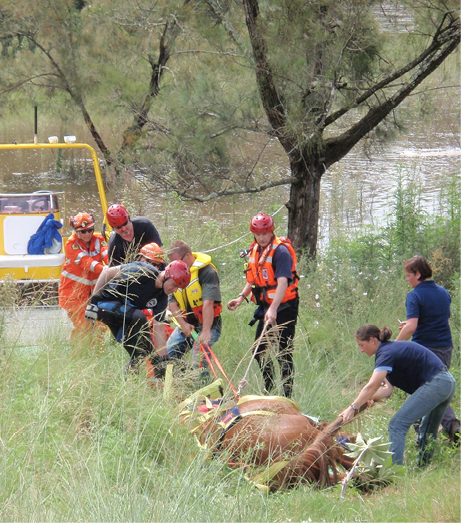
The hauling party dragged the first horse, which was sedated and strapped securely to a rescue glide, to the flat-bottomed bow-loading flood boat. Two vets (at right in blue) constantly monitored the medical condition of the horse.
Both veterinarians accompanied the horse on the boat for the ten-minute journey to the boat ramp on the opposite bank, with supplementary sedation at the ready to ensure the safety of all on board. Once on dry land the rescue glide made it easier to transfer the horse to a low-loader trailer. It was driven a couple of hundred metres to a holding yard (safe zone) where one veterinarian stayed with it until it recovered. By this time the second rescue glide was on the rescue boat and the team was on its way back to the island to repeat the process for the second horse with a second veterinarian.

The 1.2 x 2.4-metre rescue glide for large animals fits neatly into a flood boat. The vet (at right) was ready to administer further sedation should the horse begin to regain consciousness during the river crossing.
This was the first rescue of this kind that had been conducted by any of the three agencies. Its success was attributed to all persons involved being a LAR instructor or having undertaken at least the two-day LAR training course. The rescued horses were physically unscathed and later adopted.
A 32-year-old mare, with arthritis and Cushings disease, had fallen into a gully. It was at the bottom of a steep, deep, narrow gully. Its hooves were higher than its body and its head was positioned lower than the body and legs. It was unable to stand even with assistance. The Rural Fire Brigade was undertaking LAR training at the time of the call and decided to combine training with the rescue.
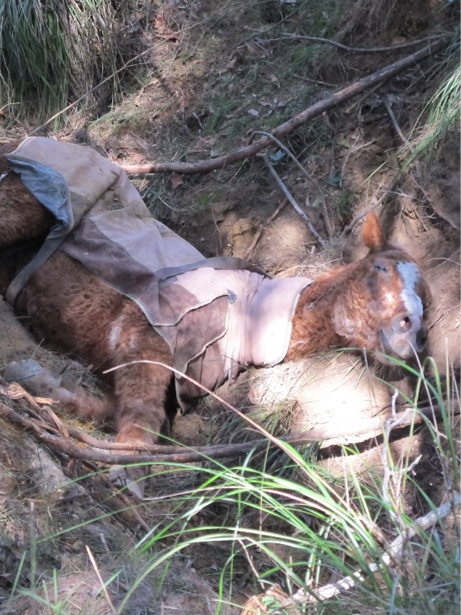
Elderly horses and the very young are particularly vulnerable to becoming trapped.
As typically encountered with entrapped horses, the mare had periods of calm followed by periods of frantic thrashing as it tried to get up, repeatedly smashing its head on the ground with each attempt. Upon the brigade’s arrival, the horse owner’s husband was in the ‘hot zone’ (the zone of greatest risk to rescuers), trying to calm the mare.
Because it was a Sunday, it took almost an hour to locate a veterinarian who was able to attend, and another 30 minutes before she arrived. That gave the brigade crew and their training instructor time to assess the risks, plan and make contingency plans, unpack equipment and establish hot, warm and cool zones in accordance with incident response protocols (Leighton & Staples 2010) and an equipment dump.
Because the mare had been down for six hours by the time the veterinarian arrived, she decided to fully anaesthetise, rather than just sedate the animal. The mare was lying on a tree root that extended the length of her body preventing the use of the strop guide. The lifting strops were ‘flossed‘ (sliding backwards and forwards) under the mare’s shoulder to the girth, and under the rump to its flank. The First Officer assisted the veterinarian to place a padded hood over the mare’s head and halter to protect it from further injury. Four members of the crew attached the sling strops to the crane. Two rescuers stood clear while two others supported the head during the lift.
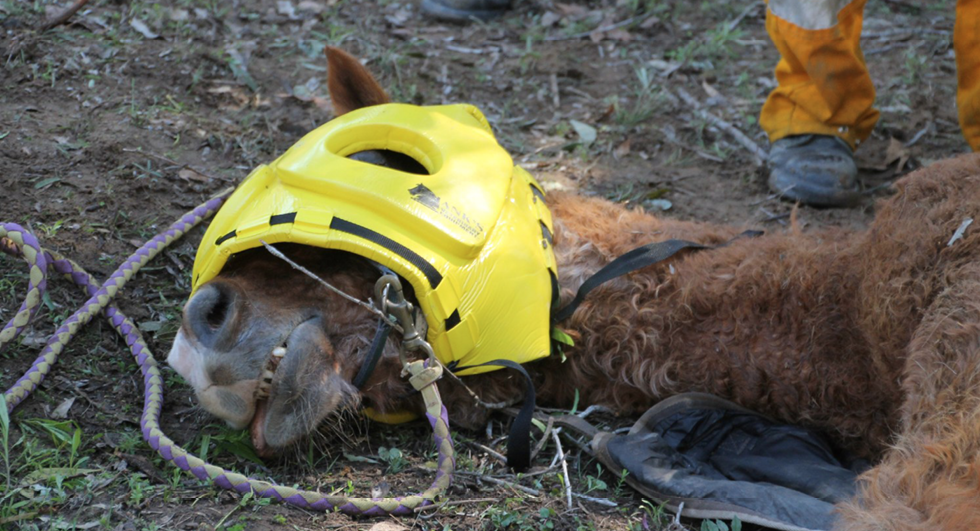
A padded hood prevents injury to the horse’s head during the rescue and while it recovers from anaesthesia.

Wide strops around the horse’s girth and flank prevent trauma to the body in those areas. A spreader bar offers a two-point lift to prevent the animal becoming unbalanced when lifted vertically by a crane.
Once extricated, the mare was rolled into a comfortable and safe position for recovery from anaesthesia. In spite of its age and the length of time it was trapped, the mare recovered fully. The brigade is now the lead agency for LAR in their region of the state. In the 18 months since this rescue, the number of rescues has risen from an average of one horse or cow rescue per year to nearly 20 large animal rescues (greater than one per month).
The difficulties described in the case studies demonstrate the need for a collaborative, multidisciplinary paradigm for animal rescue. LAR requires the same organisational principles and teamwork as for a road crash rescue or house fire. While the importance of specialist LAR training for first responders seems obvious (Smith, Thompson & Taylor 2015), the case studies illustrate the significance of all stakeholders being proficient in:
While introductory training is useful it is not a replacement for comprehensive training involving responders and veterinarians, and constant revision and practise. Overseas, minimum training standards and effective interagency collaborations have resulted from the creation of a national body. This provides capacity and knowledge that could be adapted to an Australian emergency services context for wide benefit. Beneficiaries of BARTA, for example, have included ‘sporting equine event managers, military mounted regiments, welfare organisations, livestock and equine owners, hauliers, veterinary hospitals and NGOs’ (Green 2014).
Training may also have secondary benefits in providing the impetus for stakeholders to engage in related practices and behaviours beyond the actual rescue event. For example, owners should appreciate the benefits of ensuring their domestic large animals can be easily caught, haltered, handled and transported by strangers. They might be more capable of conducting informal risk assessments of their animal’s surroundings based on their specific knowledge of the local environment. By reducing the exposure of their horses to risks such as dams, they can reduce the incidence of rescues. Veterinarians might be motivated to improve their knowledge of emergency medicine of stressed animals under challenging working environments. Indeed, the inception of BARTA has seen ‘the primary role of the veterinarian shifting from performing post incident care, to providing essential safety measures for responders in order to carry out rescues’ (Green 2014). Small animal veterinarians might become more acutely aware that they could be called on to assist in LAR, even in urban environments, as can be the case with livestock transport accidents (Miranda-de la Lama et al. 2011) and animal-vehicle accidents (Rowden et al. 2008). First responders could appreciate the benefits of understanding and gaining skills to manage the manifestation and impact of close human-animal bonds on the behaviour of animal owners, the public, and the media. This knowledge could improve interdisciplinary communication while participating in or leading a rescue, and therefore improve the prospect of a successful outcome following a rescue.
The case studies reported are pertinent reminders that:
These generalisations from the case studies are entirely reasonable. However, without standardised incident reporting of animal rescues, there is no evidence base to determine best practice or evaluate the effect of interventions such as training (Howlett & Turnbull 2009) and advancement in technological aids such as glides and slings (Fürst et al. 2008, Gimenez, Gimenez & May 2004). Neither are statistics on death or injury to humans and animals during or post LAR required to be systematically collected. Both seem warranted.
Sadly, case study one provokes a clarification of the definition of ‘successful rescue’. The gelding was successfully rescued but the inefficient process led to animal euthanasia, risk exposure to the rescue team, and loss to the owner. Even if a horse seems to survive a rescue with no obvious external problems, a veterinarian should monitor the horse post-rescue as collapse or death can occur some days later (Riley 2012). With this in mind, metrics of animal rescues should distinguish between survival of the animal (or human) at the time of extrication from danger as well as recovery from the event. This necessarily provokes an important ethical debate: when to rescue and when to euthanase in situ and recover the carcass for appropriate disposal.
Finally, post-traumatic stress disorder is a common after effect of emergencies, disasters and rescues (Neria, Nandi & Galea 2008). Responders, experienced in human rescues, can be shocked at how they are affected by animal rescues, especially when they go wrong (personal communication: Anthony Hatch). Similarly, veterinarians can encounter human injuries and fatalities at LAR scenes, and high stress levels are often experienced in emergency or disaster situations (Taylor et al. 2008). This risk should be flagged in training sessions, all rescuers should engage in post rescue debriefing, and affected responders should be encouraged to seek counselling.
Bedenice D 2007, Evidence-based medicine in equine critical care. Veterinary Clinics of North America: Equine Practice, 23, 293–316.
Farm Animal Welfare Committee 2012, Opinion on Contingency Planning for Farm Animal Welfare in Disasters and Emergencies. London, UK: Department for Environment, Food and Rural Affairs.
Först AE, Keller R, Kummer M, Manera C, von Salis B, Auer J. & Bettschart-Wolfensberger R 2008, Evaluation of a new full-body animal rescue and transportation sling in horses: 181 horses (1998–2006). Journal of Veterinary Emergency and Critical Care, 18, pp. 619–625.
Gimenez R, Gimenez T & May KA 2007, Technical Large Animal Emergency Rescue, Iowa, United States, Iowa State University Press.
Gimenez RM, Gimenez T & Stafford K 2004, Implementation of the Equine Rescue Glide. Journal of Veterinary Emergency and Critical Care, 14, pp. S1–S17.
Green J 2014, What have we learned about animal rescue in the last decade? Fire Times. United Kingdom: modern media publications.
Howlett M & Turnbull C 2009, Large animal emergency rescue training, Australia, Agrifoods Skills Australia International Specialised Skills Institute.
Leighton M & Staples M 2010, Equine Emergency Rescue: a guide to Large Animal Rescue, Oxenford, Qld, Velvet Visions Press.
Miranda-de la Lama GC, Sepulveda WS, Villarroel M & María GA 2011, Livestock Vehicle Accidents in Spain: Causes, Consequences, and Effects on Animal Welfare. Journal of Applied Animal Welfare Science, 14, pp. 109–123.
Neria Y, Nandi A & Galea S 2008, Post-traumatic stress disorder following disasters: a systematic review. Psychological medicine, 38, pp. 467–480.
Riley C 2012, Emergency management of horses and food animals involved in disasters. Proc AVA NT Conference – Disaster Medicine and Management. Darwin, Australia.
Rowden P, Steinhardt D & Sheehan M 2008, Road crashes involving animals in Australia. Accident Analysis & Prevention, 40, pp. 1865–1871.
Smith B, Thompson K & Taylor M 2015, What’s the big deal? Responder experiences of large animal rescue in australia. PLoS Curr, 7(January 22). doi: 10.1371/currents.dis.71d34082943fa239dbfbf9597232c8a5.
Taylor MR, Agho KE, Stevens GJ & Raphael B 2008, Factors influencing psychological distress during a disease epidemic: data from Australia’s first outbreak of equine influenza. BMC public health, 8, p. 347.
Dr Kirrilly Thompson is a Senior Research Fellow at the Appleton Institute, the Adelaide campus of Central Queensland University. She is a trained anthropologist with research interests in human-animal relations and the cultural dimensions of risk.
MaryAnne Leighton is the Large Animal Rescue educator with Queensland Horse Council Inc. and author of Equine Emergency Rescue- a guide to Large Animal Rescue. MaryAnne has a lifetime of experience with horses and 20 years managing horse studs. For information on Large Animal Rescue in Australia see www.equineER.com
Professor Chris Riley is Professor of Equine Clinical Studies and Head of the Equine Group at Massey University, NZ. He has trained and taught veterinary students, veterinarians, and animal health workers in Australia, Canada, Haiti, New Zealand, Peru, Thailand and the United States. He has parallel research interests in animal and human welfare, their interdependence, and how veterinarians may use their skills and experience to benefit both.
1 British Animal Rescue and Trauma Care Association. At: http://bartacic.org/.